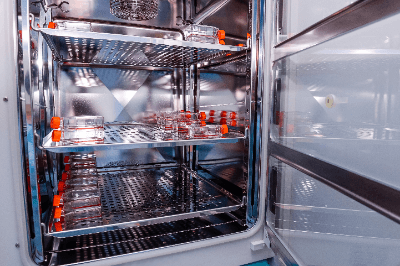What Is a Low Temperature Thermostat?
 A Low Temperature Thermostat is an environmental testing device that allows the temperature inside the incubator to be set between low and high temperatures (approximately 0°C to 60°C or approximately -10°C to 50°C).
A Low Temperature Thermostat is an environmental testing device that allows the temperature inside the incubator to be set between low and high temperatures (approximately 0°C to 60°C or approximately -10°C to 50°C).
There are large models that can be programmed to change the temperature at a set time, as well as small models that can be used on a tabletop.
Uses of Low Temperature Thermostats
Low Temperature Thermostats are a type of environmental testing equipment used for testing in fields where changes in samples at low temperatures are important. The main applications include storage and storage-related tests in the food industry, low-temperature environment tests for animals and plants, and low-temperature experiments in the biochemistry field.
Low-temperature constant-temperature conditions are also essential for some applications, and are useful for microorganism culture and preservation tests, as well as for plant and animal tissue culture and preservation tests. In addition, they is also used for durability and deterioration tests of various parts and devices.
Major applications include endurance and degradation tests in which temperature and time are programmed to reproduce temperature changes over a 24-hour period, endurance and degradation tests in which temperatures are varied to extremes of low and high temperatures, and accelerated tests of these tests. For this reason, they are installed in educational, testing, and research institutions around the world.
Principle of Low Temperature Thermostats
Low Temperature Thermostats are devices that maintain the temperature inside a chamber at a relatively low temperature. The chamber in which samples are placed has an outer wall with a heat-insulating structure that prevents the internal temperature from being affected by the external environment.
Therefore, this structure minimizes the influence of external temperature changes and keeps the internal temperature constant.
Low temperature thermostats are broadly classified into two types according to the method used to control the temperature inside the chamber: the air circulation method and the air jacket method. They are explained in the following order:
1. Air Circulation Method
In the air circulation method, a fan is used to agitate the air in the chamber to equalize the temperature. In this method, there is a device that produces temperature-controlled air outside the chamber where the sample is placed.
This air is then fed into the chamber, and a fan is used to expand and circulate the air inside the chamber to equalize the humidity distribution inside the chamber.
This system is used in relatively large low temperature thermostats.
2. Air Jacket Low Temperature Thermostat
The air jacket method does not have a fan. It has a layer of circulating air called an air jacket on the outside of the chamber. This layer generates airflow to control the temperature by heating and cooling.
Natural convection maintains a uniform temperature inside the chamber surrounded by the air jacket. In this method, there is not much dry air or excessive airflow in the chamber where the specimens are stored, which reduces damage to the specimens.
Other Information on Low Temperature Thermostats
1. Low Temperature Thermostats with Peltier Element
Some low temperature thermostats are relatively small and use a Peltier device to heat and cool the chamber. Peltier devices are semiconductors that transfer heat from a heat-absorbing surface to a heat-generating surface when electricity is applied. In such low temperature thermostats, the Peltier device is in direct contact with the outer wall of the chamber in which the sample is placed to heat and cool the interior.
Low Temperature Thermostats using Peltier elements are very compact and can be used on a tabletop. For example, some are suitable for the incubation and storage of small quantities of microtubes, vials (1-10 mL), centrifuge tubes, and petri dishes.
These small low temperature thermostats do not have the inconvenience of unstable temperatures caused by opening and closing the door, which can be a problem with larger capacity incubators.
2. Difference Between Low Temperature Thermostats and Incubators
Incubators also include devices used to protect living organisms, such as incubators for newborns. The critical difference between the two is that incubators sold for incubator use, for example, can be set at temperatures ranging from about 20°C to 40°C, which is a narrower temperature range than that of low temperature thermostats.
Some incubators also have an egg-turning function, which is necessary to return the eggs, and a humidity control function, which is necessary to create an incubation environment, and cannot be used as a replacement for low temperature thermostats.
Whether a device labeled as an incubator is a low temperature thermostat or an incubator can be determined by the temperature setting range. For example, an incubator that can be controlled from -10°C to 60°C is a low temperature thermostat, while one limited to a temperature range near body temperature of 30°C ± 10°C is an incubator.